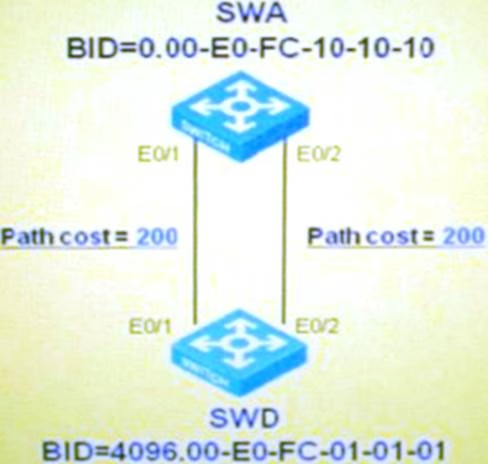H3C GB0-372-ENU H3CSE-RS-SW Online Training
H3C GB0-372-ENU Online Training
The questions for GB0-372-ENU were last updated at Feb 19,2025.
- Exam Code: GB0-372-ENU
- Exam Name: H3CSE-RS-SW
- Certification Provider: H3C
- Latest update: Feb 19,2025
Which of the following is the core goal of high-reliability redundant network design?
- A . Maximize network bandwidth
- B . Maximize network access security
- C . Minimize the existence of single point failures in the network
- D . Minimize network management complexity
The customer LAN switches SWA, SWB, and SWC form the RRPP ring main ring 1. The switch SWA has the following configuration information:
[SWA] rrpp domain 1
[SWA-rrpp-domain1] control-vlan 4092
Which of the following information can be obtained?
- A . The primary ring control VLAN on switches SWB and SWC can be different from that on SWA.
- B . All ports on switches SWA, SWB, and SWC need to be added to VLAN 4092
- C . The ports on switches SWA, SWB, and SWCRRPP rings that access the RRPP ring need to be added to VLAN 4092
- D . To facilitate network management, you can configure an IP management address on VLAN 4092.
Which of the following statements about the principle of SmartLink & Monitor Link is correct?
- A . SmartLink is a port linkage solution that monitors the device uplink. The Up/Down status change of the uplink triggers the Up/Down change of the downlink.
- B . MonitorLink implements redundant backup of the primary and backup links, and enables traffic to be quickly switched to the backup link when the primary link fails.
- C . MonitorLink sends Flush messages to notify other devices to refresh the MAC address forwarding table and ARP table entries.
- D . SmartLink sends Flush messages to notify other devices to refresh MAC address forwarding entries and ARP entries.
Which of the following statements about the PIM SM registration process are correct?
- A . Unlike the PUSH method of PIM DM, in PIM SM, the multicast source starts sending multicast traffic only when there are downstream receivers.
- B . When the multicast source initially sends traffic, the DR connected to it will encapsulate several empty Register messages to register with the RP
- C . After receiving the source registration message for the first time, RP will send a (*, G) join message to the multicast source and establish a (*, G) table entry along the way.
- D . After the RP receives the multicast forwarding traffic from the multicast source, it forwards the traffic to its downstream interface until it reaches the multicast receiver, forming an RPT from the RP to the multicast receiver along the way.
The network topology is shown in the figure. STP is enabled on SWA and SWD. Which of the following statements about the changes in the status of SWA and SWD ports are correct?

- A . SWD port E0/1 will change from a designated port to a root port in the Listening state.
- B . If the cost value of the SWD port E0/2 link is changed to 100, port E0/2 will immediately become the new root port and enter the Forwarding state.
- C . If the bridge priority of SWD is set to 0, the ports E0/1 and E0/2 of SWD will enter the Forwarding state after the Listening state and the Learning state.
- D . If the bridge priority of SWD is set to 0, the role of port E0/1 of SWA will change from designated port to root port, and the port will maintain the Forwarding state during the change.
Which of the following statements about BSR and RP in PIMSM are correct?
- A . There can only be one BSR in a PIMSM domain.
- B . There can be only one C-BSR in a PIMSM domain
- C . There can only be one RP in a PIMSM domain.
- D . There can be only one C-RP in a PIMSM domain.
Which of the following belongs to the function of the convergence layer?
- A . Has a large number of interfaces for connecting to end-user computers
- B . Access security control
- C . High-speed packet switching
- D . Complex routing strategies
The customer has two switches SWA and SWB connected together through a LAN. The two switches SWA and SWB form a link aggregation group. Check the aggregation group status on SWA as follows:
[SWA] display link-aggregation verbose
Loadsharing Type: Shar — Loadsharing , NonS — Non-Loadsharing Port Status: S — Selected , U — Unselected
Flags: A — LACP_Activity , B — LACP_Timeout , C — Aggregation , D — Synchronization , E — Collecting , F — Distributing , G — Defaulted , H — Expired
System ID: 0x8000 , 000f-e245-6bc0 Local :
Port StatusPriority Oper-KeyFlag GE1/0/1S 327682 {ACDEF}KOKOMADE
GE1/0/2S 327682 {ACDEF}KOKOMADE
GE1/0/3S 327682 {ACDEF}KOKOMADE
Remote :
ActorPartner Priority Oper-KeySystemID Flag
GE1/0/125327682 0x8000 , 000f-e23d-59f0 {ACDEF}KOKOMADE GE1/0/226327682 0x8000 000f-e23d-59f0 {ACDEF}KOKOMADE GE1/0/327327682 0x8000 000f-e23d-59f0 {ACDEF}KOKOMADE
What can we learn from the above information?
- A . A static aggregation group is established between switches SWA and SWB.
- B . A dynamic aggregation group is established between switches SWA and SWB.
- C . LACP priority is 0x8001
- D . Link aggregation port bandwidth size 2G
Before configuring Layer 3 multicast, which of the following is the first thing you need to do?
- A . Enter IGMP view
- B . SB sets the IGMP protocol version
- C . Configure the PIM protocol
- D . Enable multicast globally using the multicast routing-enable command
Which of the following addresses is not an IPv4 multicast address?
- A . 232.255.255.255
- B . 242.255.255.250
- C . 239.255.255.255
- D . 224.0.0.13
Latest GB0-372-ENU Dumps Valid Version with 432 Q&As
Latest And Valid Q&A | Instant Download | Once Fail, Full Refund

